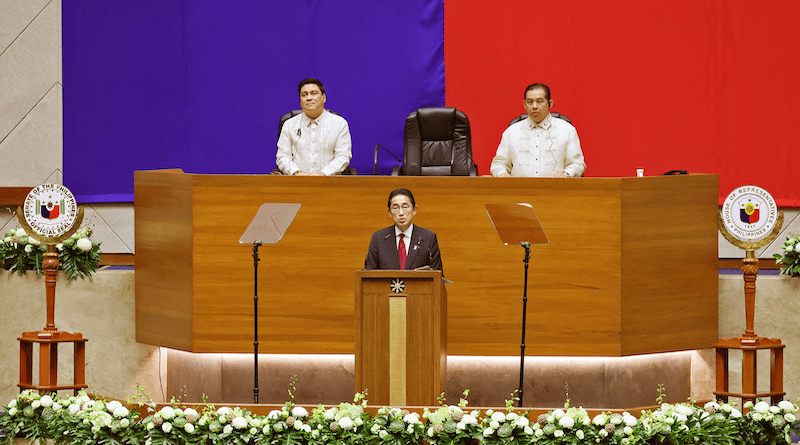No Backing Down For Tokyo’s Renewed Threat Mitigation – Analysis
Japan’s Prime Minister Fumio Kishida’s inaugural two-day visit to Malaysia heralded a new strategic bulwark of defence and security criticality. Apart from strengthening defence diplomacy with China in mind, the importance of Malaysia assuming the chairmanship of Asean in 2025 remains at the forefront.
Japan is now entering the elite world of defence and security diplomacy and charm offensive,both in hard and soft power expansion.
Kishida’s charm offensive tour in Southeast Asia was initiated with Beijing in mind, and has announced a support of the coastal radar system to Manila valued at $4 million.
The OSA’s initial pool of recipients include Malaysia, Bangladesh and Fiji, all being at the forefront of critical strategic security calculations for Japan and the region. Each would be allotted a quarter of this fiscal year’s 2 billion yen OSA budget. However, limitations and questions remain on the future sustainability of this drive, as the yen took a hit and guidelines being put in place including the Three Principles on the Transfer of Defense Equipment and Technology, will restrict OSA to nonlethal equipment such as communications satellite systems and surveillance radar.
The OSA might be seen by some as too little too late in its overall efficacy and lasting potential,with its limitations in terms of budget and self imposed constraints on arms sales, but it remains a critical front for Tokyo to both bolster its regional collective security framework as a supplementary fallback to the current Camp David tripartite axis of defence and the Quad.
Tokyo is also cognisant that any potential future move on Taiwan by Beijing will implicate it directly in an expanded conflict involving the risks of being the target of preemptive strikes on US bases that it currently hosts. This remains a vital strategic military need for Beijing to weaken the support and fallback capacities needed by the US in the all-out affront containing the forces of China in attacking Taiwan.
Tokyo’s biggest defence spending since WWII in view of the three pronged threat has seen it maintaining its lead in defence readiness. The doubling of its defence budget from 1% to 2% of GDP will see it poised to become the third largest military in the world, behind the US and China, if it stays consistent for the next five years.
Despite the concerns on its currency decline, major procurement initiatives including the F-35A/B, and P-1 maritime patrol, are unaffected, according to Global Data. Japan realizes that despite the risks of its currency devaluation impacting on its overall security postures and budget including plans for its own sixth generation fighter jets, its own near term security and deterrence readiness in the Indo Pacific in particular will remain the biggest priority.
In the naval warfare capacity renewal, Japan is enhancing its blue-water capabilities by transforming the current capacities of its Izumo class helicopter carriers that can be turned into fully-functional aircraft carriers that can accommodate the F-35B fighter aircraft.
Faced between appropriately navigating its global deployment needs and protecting its near water security from Beijing, particularly the southwestern islands that are facing potential challenges from Chinese threats, the Japan Self-Defense Force (JSDF) and US forces are integrating their models and approaches in island chain defence, enhancing interoperability and bolstering the deterrence bulwark against threats to both Tokyo and Taipei.
It will need to offer more than these, and the OSA comes into the complete picture for Tokyo, as it realizes that players in the region are in need of a strong third force that is based on stability and trust as they avoid being sucked into the endless abyss of the Sino-US rivalry
They are not keen to choose a side, but also at the same time are heavily dependent on Washington in providing the security assurance and bulwark.
By doing so, they risk further economic retaliations from Beijing and as such, Tokyo’s assurance both in economic and security alternative remain critical for these players
Tokyo is seeking to capitalize on this opening and in reasserting its once dominant position of influence in this region before the rise and expansion of China.
This new drive encompasses both direct and bilateral approach as well as engagement with regional and international organisations in a multilateral approach, especially with ASEAN, OIC, GCC, OPEC, and others.
These players in the region that sit at the critical geostrategic importance of maritime trade and security routes, especially Malaysia, Indonesia, Singapore and India, present a direct role in ensuring Japan’s future food and energy security as well as in providing the critical support line during times of conflict.
Malaysia’s role in palm oil, semiconductor and rare earths influence in the Lynas plant and new potential rare earths development and cultivation in the country remain critical for Japan.
The Lynas plant in Kuantan is strategically vital for Tokyo, for rare earths security and it has invested a huge sum in Lynas for future returns.
The outlook in the long future remains that it is no longer adequate in ensuring Tokyo’s consistent and comprehensive defence returns and economic sustainability within the realm of the Indo Pacific, especially since Beijing has long broadened and expanded its global economic and security agenda ranging from near waters to as far as Latin America in port building and economic dependency efforts via its trademark BRI flagship.
What Japan lacks in the depth of BRI’s soft power building capacity both in financial and security network might, it makes up with its far greater and longer legacy and tradition of trust, confidence, and mutually acceptable hallmarks of responsible and sustainable economic, security and investment agenda underscored by standards and values.

